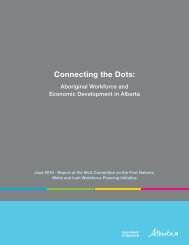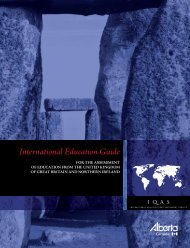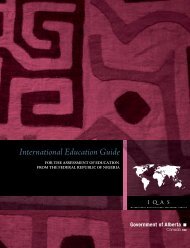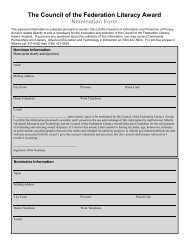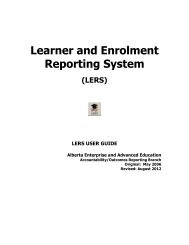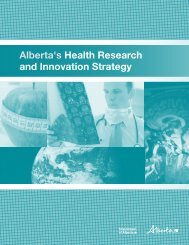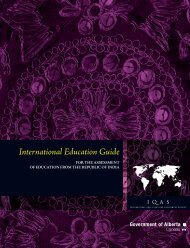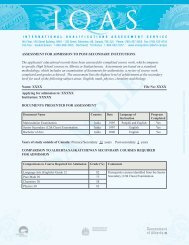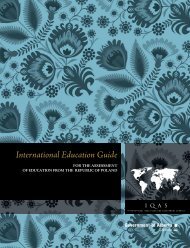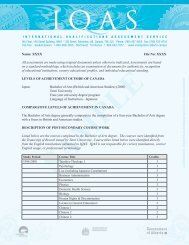International Education Guide - Enterprise and Advanced Education ...
International Education Guide - Enterprise and Advanced Education ...
International Education Guide - Enterprise and Advanced Education ...
You also want an ePaper? Increase the reach of your titles
YUMPU automatically turns print PDFs into web optimized ePapers that Google loves.
.6<br />
INTERNATIONAL EDUCATION GUIDE for the assessment of education from the Islamic Republic of Pakistan<br />
Historical <strong>Education</strong><br />
Overview<br />
Although Islamic education in present-day Pakistan<br />
dates back to the early eighth century, the current system<br />
has developed largely on the basis of Western-style<br />
education from the British colonial period. Since gaining<br />
independence in 1947, Pakistan has exp<strong>and</strong>ed its education<br />
system to meet the needs of a rapidly growing population.<br />
Traditional <strong>Education</strong><br />
(Before the 19th Century)<br />
Islamic education in present-day Pakistan began in the<br />
early eighth century, when the Arab general Muhammad<br />
bin Qasim brought Islam to Sindh. Islamic culture in the<br />
form of art, literature <strong>and</strong> architecture, as well as religious<br />
studies <strong>and</strong> education, spread across the subcontinent<br />
during the Delhi Sultanate (1206–1526) <strong>and</strong> flourished<br />
in the heyday of the Mughal Empire (1526–1858). The<br />
languages of instruction at Islamic schools, commonly<br />
known as madrassas or madaris, were Persian <strong>and</strong> Arabic.<br />
The madrassas provided both religious <strong>and</strong> secular training,<br />
teaching a wide range of subjects such as architecture,<br />
drawing, grammar, literature, logic, mathematics, medicine<br />
<strong>and</strong> philosophy.<br />
The British Period<br />
(Early 19th Century to 1947)<br />
The formal education system of modern Pakistan has its<br />
roots in the British rule of the Indian subcontinent. In 1813<br />
the British East India Company assumed responsibility<br />
for the education of Indians. At that time there was a great<br />
controversy between supporters of indigenous education<br />
<strong>and</strong> those who advocated for Western learning. Macaulay’s<br />
Minute on <strong>Education</strong> of 1835 argued for the promotion of<br />
Western learning through the English language, with a view<br />
to forming “a class who may be interpreters between us <strong>and</strong><br />
the millions whom we govern; a class of persons, Indian<br />
in blood <strong>and</strong> colour, but English in tastes, in opinions,<br />
in morals <strong>and</strong> intellect.” The governor general of India<br />
accepted the proposal <strong>and</strong> ordered all education funds to be<br />
allocated for teaching English literature <strong>and</strong> science to the<br />
native population.<br />
The government of India under the British rule, which took<br />
over control of India from the East India Company in 1858,<br />
appointed a number of commissions to study education <strong>and</strong><br />
formulated policies based on their recommendations. For<br />
example, while rejecting the idea of compulsory primary<br />
education, the government resolution on educational policy<br />
of 1913 acknowledged that literacy <strong>and</strong> primary education<br />
should have a predominant claim on public funds, <strong>and</strong><br />
proposed to double the 4.5 million enrolment of public<br />
primary schools in the “not distant future.” As it turned<br />
out, few of the recommendations <strong>and</strong> policies were fully<br />
implemented, in part due to two world wars <strong>and</strong> the Great<br />
Depression. Nevertheless, an educational administrative<br />
structure was developed covering elementary <strong>and</strong> secondary<br />
as well as higher education.<br />
The Government of India Act of 1935 clarified the role<br />
of the central <strong>and</strong> state governments in education: most<br />
educational activities fell under the jurisdiction of state<br />
governments, with the central government becoming<br />
responsible for the national library <strong>and</strong> museums, the<br />
preservation of ancient monuments, the Banaras Hindu<br />
University <strong>and</strong> the Aligarh Muslim University, <strong>and</strong> for<br />
education in centrally administered areas.<br />
The British system was basically elitist. Its main objective<br />
was not mass education but the training of a class of civil<br />
servants for colonial government. Only the aristocracy, the<br />
upper <strong>and</strong> upper middle classes, <strong>and</strong> senior officials of the<br />
British bureaucracy <strong>and</strong> military could send their children<br />
to English-language schools. Children from middle <strong>and</strong><br />
working classes attended vernacular-language schools.<br />
Those from very poor families could only go to madrassas,<br />
which charged no tuition <strong>and</strong> even provided free room <strong>and</strong><br />
board. Thus one’s position <strong>and</strong> status in society roughly<br />
corresponded to the type of school one attended. The<br />
socioeconomic stratification supported by three separate<br />
school systems has persisted to the present day.<br />
A lasting legacy of British rule in India was the development<br />
of modern universities. 1817 saw the establishment of<br />
India’s first Western-style college, the Hindu College<br />
in Calcutta, later renamed Presidency College to admit<br />
non-Hindu students. In 1857, universities were created<br />
in Bombay, Calcutta <strong>and</strong> Madras. The University of<br />
the Punjab at Lahore was established in 1882 <strong>and</strong> the<br />
University of Allahabad in 1887. Modelled after the<br />
University of London, these early universities functioned<br />
mainly as examining <strong>and</strong> degree-granting bodies; teaching<br />
took place at affiliated colleges. The Indian Universities




